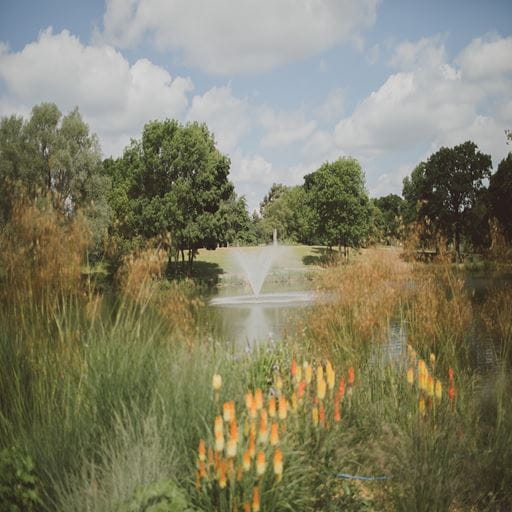Biodiversity and Grounds

Biodiversity
Biodiversity plays an important role at the University. Our Colchester Campus is set in a former deer park on the banks of the Colne River. The grounds of the campus retain relict acidic grassland, a scarce habitat type. Together with taller grassland, scrub and lakes, these form a complex mosaic of habitats with an extremely rich invertebrate fauna.
The campus also contains rare coastal grazing marsh and many notable specimen trees, including oaks, redwoods and black poplars. There are 18 major habitats on the Colchester Campus.
Colchester Campus habitats and biodiversity survey and plan map (.gif)
Hedgehog Friendly Campus
Hedgehog numbers in the UK have declined by up to half since the year 2000. It is now estimated that there are fewer than 1 million left. By undertaking the actions listed below, the University of Essex has become a safe space for hedgehogs to thrive.
We will be completing a set of actions to make our Colchester campus a safe space. This includes:
- Making sure our campus is litter free. We currently employ two full-time litter pickers that keep our campus looking beautiful.
- We have a set of hedgehog boxes around our campus that can keep the hedgehogs safe and dry.
- Creating a campaign that highlights hedgehog welfare and a range of issues that can be combated.
- The Grounds Team have left natural log piles on our campus. Log piles provide a source of food for hedgehogs and a shelter for them to sleep in.
Hedgehogs are nocturnal mammals and, if seen out during daylight hours, may be in trouble. If you see a hedgehog out during the day, contact the British Hedgehog Preservation Society on
01584 890801 for advice and (if required) details of your nearest hedgehog rescue.
Colchester Campus habitats and biodiversity survey
1. Poplars Row
Location: Along Boundary Road
Description: Row of poplars along road banks of grassland up to west facing buildings
Key plants and insects: Black poplars and Carolina poplars
2. Nightingale Wood
Location: SW corner of campus
Description: Mixed woodland
Key plants and insects: Oaks, nightingales in spring
3. Skipper's Meadow
Location: SW corner of campus
Description: Open grassland next to Nightingale Wood
Key plants and insects: Acid grassland species
4. Grazing Marsh
Location: Between railway line and Boundary Road
Description: High quality freshwater grazing marsh (designated habitat)
Key plants and insects: Relict grazing-marsh retaining many typical spp, eg Grass Vetchling, Dittander, Hairy Buttercup and Divided Sedge; larger drains support Common Reed
5. Green Lane
Location: Lane by side of campus to railway line
Description: Sunken lane
Key plants and insects: Mix of woodland species
6. South Courts Grassland
Location: Inside Boundary Road bend
Description: Lawns, grassland, scrub and mature trees
Key plants and insects: Subterranean clover, rare black poplar trees
7. Cherry Row
Location: Inside Boundary Road to bus stop
Description: Row of trees and rough grassland
Key plants and insects: Cherry trees and elms
8. Kidney Wood
Location: West of sports centre towards towers
Description: Mature woodland trees
Key plants and insects: Oaks and sweet chestnuts; three pencil oaks
9. Hance Meadow
Location: NW of car park and NE of Ivor Crewe lecture hall
Description: Acid grassland with birch trees
Key plants and insects: Oak, silver birch, subterranean clover (rare), sheep's sorrel, mosses and lichens
10. Oak Parkland and the two lower lakes
Location: North of path to Wivenhoe House
Description: Parkland
Key plants and insects: 400 year old oaks, remains of what Constable described as "a beautiful wood and piece of water"; some American oaks (Q borealis)
11. Ha-Ha and House Pleasure Gardens
Location: Wivenhoe House gardens to Ha-Ha
Description:Landscape of parkland, mature trees
Key plants and insects:Two 200 year old cork oaks
12. Ice House and Pleasure Gardens
Location: Gardens north of Wivenhoe House, containing the old ice house, includes laurel ride along back
Description: Large notable specimen trees, mainly coniferous, laurel ride gardens to ice house
Key plants and insects: Five large Redwoods, Weymouth or Eastern-White Pines, cedars, Wellingtonias, tulip tree, plus other specimen trees
13. Campus Farm and Pond
Location: East of Wivenhoe House
Description: Farm/allotments to the north of the old pond. Old pond with some wetland plants
Key plants and insects: Acid grassland Garden trees
14. Kingfisher Lake
Location: Top lake, between Vice-Chancellor's house and road
Description: Wetland habitat
Key plants and insects: Fallen mature mulberry tree
15. Bluebell Wood
Location: Shelter belt alongside main road from lake to middle lodge
Description: Woodland along Clinghoe Hill road
Key plants and insects: Oak, ash, sweet chestnut, bluebells
16. Benton's Top Heath and Hay Meadows
Location: Triangle of heathland
Description: Large expanse of acid grassland
Key plants and insects: Relict acidic grassland, a scarce habitat with an extremely rich invertebrate fauna. Dominated by Red Fescue, Sheep's Sorrel and Field Wood-rush, with rare Slender Parsley-piert and Blinks occurring in damp seepage areas
17. Rookery Wood
Location: West of middle lodge and the 1845 carriage way
Description: Holm oaks, ash, elms, hornbeam
18. Lower Heath and Woods
Location: Research park site
Description: Mature trees
UoE Sustainability on social media:



